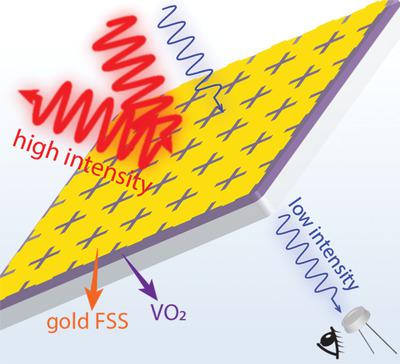当前位置:
X-MOL 学术
›
Laser Photonics Rev.
›
论文详情
Our official English website, www.x-mol.net, welcomes your
feedback! (Note: you will need to create a separate account there.)
Ultrathin Broadband Reflective Optical Limiter
Laser & Photonics Reviews ( IF 9.8 ) Pub Date : 2021-04-29 , DOI: 10.1002/lpor.202100001
Chenghao Wan 1, 2 , Zhen Zhang 3 , Jad Salman 1 , Jonathan King 1 , Yuzhe Xiao 1 , Zhaoning Yu 1, 4 , Alireza Shahsafi 1 , Raymond Wambold 1 , Shriram Ramanathan 3 , Mikhail A. Kats 1, 2, 4
Laser & Photonics Reviews ( IF 9.8 ) Pub Date : 2021-04-29 , DOI: 10.1002/lpor.202100001
Chenghao Wan 1, 2 , Zhen Zhang 3 , Jad Salman 1 , Jonathan King 1 , Yuzhe Xiao 1 , Zhaoning Yu 1, 4 , Alireza Shahsafi 1 , Raymond Wambold 1 , Shriram Ramanathan 3 , Mikhail A. Kats 1, 2, 4
Affiliation

|
Optical limiters are nonlinear devices that feature decreasing transmittance with increasing incident optical intensity, and thus can protect sensitive components from high-intensity illumination. The ideal optical limiter reflects rather than absorbs light in its active (“limiting”) state, minimizing risk of damage to the limiter itself. Previous efforts to realize reflective (rather than absorbing) limiters were based on embedding nonlinear layers into relatively thick multilayer photonic structures, resulting in substantial fabrication complexity, reduced speed and, in some instances, limited working bandwidth. In this paper, these tradeoffs are overcome by using the insulator-to-metal transition (IMT) in vanadium dioxide (VO2) to achieve intensity-dependent modulation of resonant transmission through aperture antennas. Due to the large change of optical properties across the IMT, low-quality-factor resonators are sufficient to achieve high on–off ratios in the transmittance of the limiter. As a result, our ultrathin reflective limiter (thickness ≈1/100 of the free-space wavelength) is broadband in terms of operating wavelength (>2 µm at 10 µm) and angle of incidence (up to ≈50° away from the normal). Our analysis of the experimental results via opto-thermal simulations provides insight into limiter performance and is a useful guidance for further engineering efforts.
中文翻译:

超薄宽带反射光限幅器
光限幅器是非线性器件,其特点是透射率随着入射光强度的增加而降低,因此可以保护敏感元件免受高强度照明的影响。理想的光学限制器在其活动(“限制”)状态下反射而不是吸收光,从而最大限度地降低限制器本身损坏的风险。以前实现反射(而不是吸收)限制器的努力是基于将非线性层嵌入到相对较厚的多层光子结构中,从而导致制造复杂性、速度降低,并且在某些情况下,工作带宽有限。在本文中,通过在二氧化钒 (VO 2) 以通过孔径天线实现谐振传输的强度相关调制。由于 IMT 上光学特性的巨大变化,低品质因数谐振器足以在限制器的透射率中实现高开关比。因此,我们的超薄反射限幅器(厚度 ≈ 自由空间波长的 1/100)在工作波长(在 10 µm 处 >2 µm)和入射角(距法线最大 ≈50°)方面是宽带的)。我们通过光热模拟对实验结果的分析提供了对限幅器性能的深入了解,并且为进一步的工程工作提供了有用的指导。
更新日期:2021-06-10
中文翻译:

超薄宽带反射光限幅器
光限幅器是非线性器件,其特点是透射率随着入射光强度的增加而降低,因此可以保护敏感元件免受高强度照明的影响。理想的光学限制器在其活动(“限制”)状态下反射而不是吸收光,从而最大限度地降低限制器本身损坏的风险。以前实现反射(而不是吸收)限制器的努力是基于将非线性层嵌入到相对较厚的多层光子结构中,从而导致制造复杂性、速度降低,并且在某些情况下,工作带宽有限。在本文中,通过在二氧化钒 (VO 2) 以通过孔径天线实现谐振传输的强度相关调制。由于 IMT 上光学特性的巨大变化,低品质因数谐振器足以在限制器的透射率中实现高开关比。因此,我们的超薄反射限幅器(厚度 ≈ 自由空间波长的 1/100)在工作波长(在 10 µm 处 >2 µm)和入射角(距法线最大 ≈50°)方面是宽带的)。我们通过光热模拟对实验结果的分析提供了对限幅器性能的深入了解,并且为进一步的工程工作提供了有用的指导。

































 京公网安备 11010802027423号
京公网安备 11010802027423号